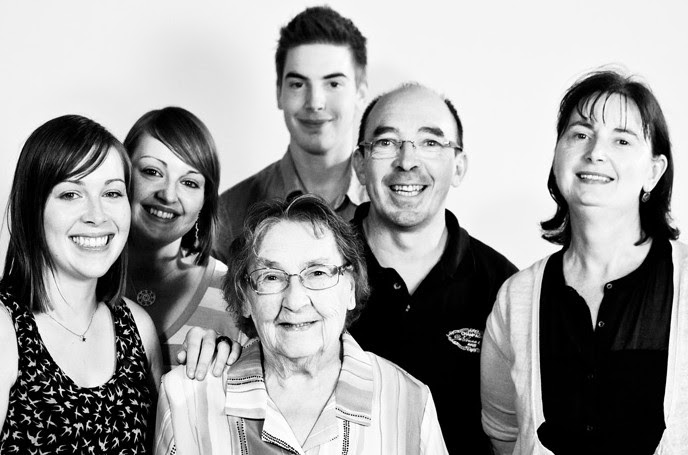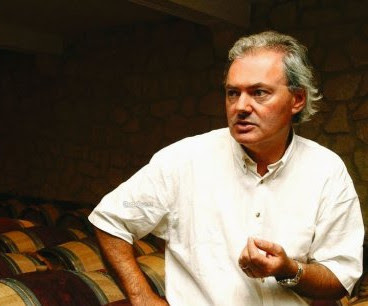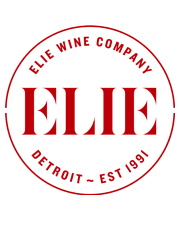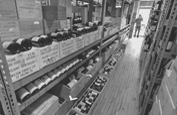Saturday Sips: High Altitude Spanish Red with a Mediterranean Touch
Mas l’Altet “Avi” (Valencia, 2009)
$210/6-pack (~$35/bottle)
The husband-and-wife team of Alfredo Esteve and Nina Coolsaet are the heart and soul behind Bodega Mas l’Altet. Both engineers, the couple met by happenstance on their first day of master’s study of oenology. When Alfredo entered the classroom there was only one seat open, and it was right next to Nina. The rest, as they say, is history.
 When the time came to start their own project, Alfredo and Nina turned to family history for inspiration. Alfredo’s beloved grandfather was a farmer who shared with his grandson the dream of reviving the winemaking tradition on the family land, where the vines were all lost a century ago to the Phylloxera epidemic. Together, the couple planted five acres of vines at about 1800 feet of elevation on this precious piece of earth near the east coast of Spain.
When the time came to start their own project, Alfredo and Nina turned to family history for inspiration. Alfredo’s beloved grandfather was a farmer who shared with his grandson the dream of reviving the winemaking tradition on the family land, where the vines were all lost a century ago to the Phylloxera epidemic. Together, the couple planted five acres of vines at about 1800 feet of elevation on this precious piece of earth near the east coast of Spain.
As an homage to Alfredo’s grandfather they decided to call the resulting wine “Avi” – the Catalan word for “grandfather.” Indeed, the 2009 vintage of “Avi” has even more significance for the winemaking couple. It is the year their son Luka was born on the very day that they began the harvest.
The couple’s vineyard is situated in the southern portion of the DO Valencia in a microclimate that benefits both from the cooling effect of high elevation and the warmth of the nearby Mediterranean Sea. This ensures long, even ripening of the fruit. Because the land they are farming is relatively small, Alfredo and Nina are vineyard purists, essentially treating it as their garden and striving for balance and harmony with utmost respect for Mother Nature.
2009 “Avi” is a blend of 65% Syrah, 26% Cabernet Sauvignon, 5% Merlot and 4% Garnatxa. Deeply aromatic and bountiful with ripe fruit, the fitness of the vineyards are evident in the glass. As you might suspect, with only five acres, yield is miniscule. In 2009 just over 500 cases of “Avi” were produced.
- - -
Posted on 2016.03.02 in Saturday Sips Wines, Spain DO, Valencia | Read more...
Revisiting a Seductive Mediterranean Red
Domaine Les Mille Vignes “Cadette” (Fitou, 2012)
$248/6-pack (~$41/bottle)
Loyal readers of our “Saturday Sips” email know that we rarely feature a wine and vintage that we’ve done before. But after drinking a stunningly good bottle of 2012 Domaine Les Mille Vignes “Cadette” recently we decided that there can be exceptions to this principle.
“Cadette” is a blend of equal parts Grenache, Carignan and Mourvèdre from vines over 50 years old. The aromatics explode from the glass with red currant jelly, wild thyme and lavender scrubland, roasted stones, smoky meats, and soul. The layered palate is medium-bodied, ripe, and balanced by freshness and energy. While it’s a wine that is immediately sensual, if you spend a little time with it you’ll see that its beauty is profound. It’s the ideal wine to transition into spring and pair with a hunk of charcoal-grilled red meat when there’s still a bite in the air and the crocus flowers are just beginning to break the soil.
Situated on the coastal area between Spain and where the Rhône empties into the Mediterranean Sea, the Languedoc-Roussillon has always been a highly productive wine-making zone. It’s really been in the past handful of decades that more ambitious winemakers have taken full advantage of soils and micro-climates that are capable of producing world-class wine. Because some of these exceptional sub-zones of the Languedoc-Roussillon are small and somewhat obscure to the rest of the world, prices are still quite reasonable given the quality and aging potential that many of the wines possess.
 Fitou is one of these sub-zones. It is the very first granted appellation in Languedoc. It consists of two small enclaves, Fitou Haut, a patch of mountainous schist 15 miles inland, and Fitou Maritime, a clay-limestone band around the saltwater lagoons on the coast. It was late 1970s, in the Fitou Maritime, that a retired oenology professor from Orange, Jacques Guérin, launched Domaine Les Mille Vignes. Today it’s Jacques’ daughter, Valérie Guérin, who is carrying on the ethic of low yields, organic principles, hand-harvesting, and native yeast fermentation.
Fitou is one of these sub-zones. It is the very first granted appellation in Languedoc. It consists of two small enclaves, Fitou Haut, a patch of mountainous schist 15 miles inland, and Fitou Maritime, a clay-limestone band around the saltwater lagoons on the coast. It was late 1970s, in the Fitou Maritime, that a retired oenology professor from Orange, Jacques Guérin, launched Domaine Les Mille Vignes. Today it’s Jacques’ daughter, Valérie Guérin, who is carrying on the ethic of low yields, organic principles, hand-harvesting, and native yeast fermentation.
It’s not by luck that Domaine Les Mille Vignes’ wines can be found on starred restaurant wine lists in Paris. Their old vines and low yields allow the wines to reach their full, seductive potential. With all aging done in stainless steel vats, the wines are all about purity of fruit and the distinction of Fitou. You could rest some “Cadette” in the cellar for five years or more if you can keep your hands off of it now.
- - -
Posted on 2016.02.26 in France, Saturday Sips Wines, Languedoc-Roussillon | Read more...
Rich & Complex Grand Cru Blanc de Blancs Champagne
Erick De Sousa Brut Réserve Grand Cru Blanc de Blancs
Champagne De Sousa is a family affair. Erick and his wife, Michelle, head the estate. Their two daughters Charlotte and Julie, and son, Valentin, have all studied winemaking and take roles in the family business to different degrees.  Erick and his team farm close to 24 acres of vines spread over 42 plots. Most are in the Côte des Blancs subregion of Champagne in the Grand Cru commune of Avize. The sub-soil there consists entirely of Belemnite chalk – an accumulation of cuttlefish fossils and the geological imprint of the Paris Basin that is known for growing superior fruit for sparkling wines. This is the same Grand Cru vineyard real estate that goes into the tête de cuvées of the big-name Champagne houses that quite often sell for three or four times the price. The Blanc de Blancs Erick creates from this hallowed ground and old vines is as bold and rich as they come.
Erick and his team farm close to 24 acres of vines spread over 42 plots. Most are in the Côte des Blancs subregion of Champagne in the Grand Cru commune of Avize. The sub-soil there consists entirely of Belemnite chalk – an accumulation of cuttlefish fossils and the geological imprint of the Paris Basin that is known for growing superior fruit for sparkling wines. This is the same Grand Cru vineyard real estate that goes into the tête de cuvées of the big-name Champagne houses that quite often sell for three or four times the price. The Blanc de Blancs Erick creates from this hallowed ground and old vines is as bold and rich as they come.
Erick is meticulous in his vineyards. He’s been farming using biodynamic methods for the past 17 years. The vineyards are plowed with horse (usually by his daughter Julie) to help prevent the soils from becoming compact and to promote healthy insect life underground. Yields are low and all fruit is harvested by hand and fermented with indigenous yeasts. He allows his wines to go through full malolactic (secondary) fermentation that takes the hard edge off the finish.
The result of all this work are wines that are easygoing yet profoundly delicious, generous with fruit, and a delightful sense of buoyancy, pleasing to both the casual drinker and the most discerning aesthete.
Stop by this Saturday to sample an outstanding 100% Chardonnay Champagne ideal for sharing with your sweetheart or anyone that just loves good wine. Even if you’re not romantically involved, like any good holiday, the meaning of Valentine’s Day is flexible enough to cover just about anyone’s fancy. Let the Finnish version of Valentine’s Day be your guide. It’s called Ystävänpäivä, which translates into “Friend’s Day.” What better justification for a Champagne dinner than good friends?
- - -
Posted on 2016.02.11 in France, Saturday Sips Wines, The Champagne Society, Champagne | Read more...
2012 “Second Wines” from Top Bordeaux Châteaux
Our Bordeaux MasterClass was a hit. With over 100 people in attendance we filled the Birmingham Community House Ballroom with a lively crowd. There was plenty of insight to be had tasting through three vintages of wines from four different Châteaux with discussion led by Proprietors and General Directors of each Château. With the glow from the tasting still upon us, we all made our way to Fleming’s Prime Steakhouse and Tallulah for a delightful two-course dinner paired with some of the evening’s wines.
To keep the momentum, this Saturday we’re doing another small comparative tasting of two “Second Wines” from opposing banks of the Gironde Estuary in Bordeaux. Not merely leftovers, Second Wines have always offered incredible value, but as the selection process for the “Grand Vin,” or First Wine of these distinguished estates has gotten stricter, today the best Second Wines offer an even greater value than in the past. It’s important to note that Second Wines are always produced by the same winemaking team that produces the First Wine. Generally, the biggest differences are that Second wines see less new oak during maturation and are meant to be enjoyed much closer to release than the First Wine.
The general observation for the 2012 vintage in Bordeaux is that it was a tremendous year for Merlot. Hot and sunny weather in August followed by a September in which hot days alternated with cool nights enhanced the concentration of the berries and their aromatic expression.
Château Villemaurine “Les Angelots” (Saint-Émilion Grand Cru Classé, 2012)
~$31/bottle
 The vineyards of Villemaurine have been producing mostly underachieving fruit for a couple of centuries. But it was the relatively recent purchase and subsequent investment in the property and cellars, including the hire of noted winemaking consultant Stéphane Derenoncourt followed by Hubert de Boüard de Laforest of Château Angélus, that has brought the estate to prominence. Saint-Émilion boasts the famous clay-based soils of “Right Bank” Bordeaux ideal for Merlot, and the Villemaurine bottling reflects this with a blend of 95% Merlot and 5% Cabernet Franc for a wine of abundant aromatics and ripe, concentrated fruit. Maturation is completed in 30% new barrels and 70% second-fill barrels.
The vineyards of Villemaurine have been producing mostly underachieving fruit for a couple of centuries. But it was the relatively recent purchase and subsequent investment in the property and cellars, including the hire of noted winemaking consultant Stéphane Derenoncourt followed by Hubert de Boüard de Laforest of Château Angélus, that has brought the estate to prominence. Saint-Émilion boasts the famous clay-based soils of “Right Bank” Bordeaux ideal for Merlot, and the Villemaurine bottling reflects this with a blend of 95% Merlot and 5% Cabernet Franc for a wine of abundant aromatics and ripe, concentrated fruit. Maturation is completed in 30% new barrels and 70% second-fill barrels.
Château Marquis de Terme “La Couronne de Marquis de Terme” (Margaux, 2012)
~$35/bottle
 Once part of the vast, 17th Century Rauzan estate of Margaux, the classified “Fourth Growth” estate of Marquis de Terme consists of gravel, sand, limestone and clay “Left Bank” soils planted with a mix of Cabernet Sauvignon, Merlot, Petit Verdot, and Cabernet Franc. The estate has been undergoing modernization for the past few decades with a new wave of investments in 2009 with the arrival of Ludovic David (one of our guests at the Bordeaux MasterClass) as the new director. La Couronne de Marquis de Terme is a choice example of the classic perfumed fragrance and blackcurrant fruit of Margaux wines.
Once part of the vast, 17th Century Rauzan estate of Margaux, the classified “Fourth Growth” estate of Marquis de Terme consists of gravel, sand, limestone and clay “Left Bank” soils planted with a mix of Cabernet Sauvignon, Merlot, Petit Verdot, and Cabernet Franc. The estate has been undergoing modernization for the past few decades with a new wave of investments in 2009 with the arrival of Ludovic David (one of our guests at the Bordeaux MasterClass) as the new director. La Couronne de Marquis de Terme is a choice example of the classic perfumed fragrance and blackcurrant fruit of Margaux wines.
- - -
Posted on 2016.02.09 in France, Bordeaux, Saturday Sips Wines | Read more...
Rich & Concentrated Grand Cru Pinot Noir of Côte de Beaune
Domaine Follin-Arbelet Corton Bressandes (Grand Cru, 2011)
$99/bottle
Franck Follin-Arbelet is a “terroirist.” He aims to allow specificity of place be evident in the wines from his vineyards of the Côte de Beaune. Eric Pfanner said it well in his Burgundy terroir piece for the New York Times that features Franck’s work: “In an era of industrial farming and standardized consumer products, this fragmentation (of Burgundy’s vineyards) may seem anachronistic, a doll’s house version of a winemaking landscape. But for those who value diversity and authenticity in what they drink, Burgundy is a microcosm of an ideal wine world.”
 Raised in Burgundy’s famous Côte d’Or, Franck began his journey with a focus on Geology. But it was in the early 90s that he was able to put his knowledge of the earth into practice by making wine with his father-in-law, André Masson, eventually taking over direction of the domaine in 1993. Franck farms sustainably without synthetic fertilizers or weed killers, working the soils regularly to aerate and keep them healthy. The domaine’s 18th Century homestead is archetypal Burgundian architecture with the winery on the ground floor beneath the first and second floor housing and above an unusually deep cellar beneficial for the development of the wines.
Raised in Burgundy’s famous Côte d’Or, Franck began his journey with a focus on Geology. But it was in the early 90s that he was able to put his knowledge of the earth into practice by making wine with his father-in-law, André Masson, eventually taking over direction of the domaine in 1993. Franck farms sustainably without synthetic fertilizers or weed killers, working the soils regularly to aerate and keep them healthy. The domaine’s 18th Century homestead is archetypal Burgundian architecture with the winery on the ground floor beneath the first and second floor housing and above an unusually deep cellar beneficial for the development of the wines.
The Bressandes “climat” of the Corton Grand Cru creates the richest, most concentrated of all Corton. At best, it is the supreme Corton, expressive and long-lived. Franck’s Corton Bressandes comes from a parcel of just over one acre of vines planted between 1955 and 1960. Vinification is in the old-school style, fermenting slowly in open-top wooden vats and using only indigenous yeasts. The wines are aged in barrels and then bottled in all of their unadulterated glory, unfined and unfiltered.
- - -
Posted on 2016.01.29 in France, Saturday Sips Wines, Burgundy | Read more...
Featured Wines
- Notebook: A’Boudt Town
- Saturday Sips Wines
- Saturday Sips Review Club
- The Champagne Society
- Wine-Aid Packages
Wine Regions
Grape Varieties
Aglianico, Albarín Blanco, Albillo, Aleatico, Alicante Bouschet, Altesse, Arcos, Aubun, Auxerrois, barbera, Beaune, Bonarda, Cabernet Franc, Cabernet Sauvignon, Caino, Caladoc, Carcajolu-Neru, Carignan, Chablis, Chardonnay, Chasselas, Chenin Blanc, Cinsault, Cortese, Corvina, Corvinone, Cot, Erbamat, Ferrol, Fiano, folle Blanche, Frappato, Friulano, Fromenteau, Fumin, Garganega, Garnacha, Gewurztraminer, Godello, Grenache, Grolleau, Jacquère, Lambrusco, Lladoner Pelut, Loureira, Macabeo, Macabou, Maconnais, Malvasia, Malvasia Nera, manseng, Marsanne, Melon de Bourgogne, Mencía, Merlot, Mondeuse, Montanaccia, Montepulciano, Morescola, Morescono, Moscatell, Mourv, Mourvèdre, Muscadelle, Nebbiolo, Nero d'Avola, Palomino, Parellada, Pecorino, Persan, Petit Meslier, Petit Verdot, Pinot Auxerrois, Pinot Blanc, Pinot Meunier, Pinot Noir, Poulsard, Prieto Picudo, Rondinella, Rose, Roussanne, Sangiovese, Sauvignon Blanc, Savignin, Semillon, Souson, Sparkling, Sylvaner, Syrah, Tannat, Teroldego, Timorasso, Trebbiano, Treixadura, trepat, Trousseau, vaccarèse, Verdicchio, Viognier, ViuraWines & Events by Date
- September 2025
- August 2025
- July 2025
- June 2025
- May 2025
- April 2025
- March 2025
- February 2025
- January 2025
- December 2024
- November 2024
- October 2024
- September 2024
- August 2024
- July 2024
- June 2024
- May 2024
- April 2024
- March 2024
- February 2024
- January 2024
- December 2023
- November 2023
- October 2023
- September 2023
- August 2023
- July 2023
- June 2023
- May 2023
- April 2023
- March 2023
- February 2023
- January 2023
- December 2022
- November 2022
- October 2022
- September 2022
- August 2022
- July 2022
- June 2022
- May 2022
- April 2022
- March 2022
- February 2022
- January 2022
- December 2021
- November 2021
- October 2021
- September 2021
- August 2021
- July 2021
- June 2021
- May 2021
- April 2021
- March 2021
- February 2021
- January 2021
- December 2020
- November 2020
- October 2020
- September 2020
- August 2020
- July 2020
- June 2020
- May 2020
- April 2020
- March 2020
- February 2020
- January 2020
- December 2019
- November 2019
- October 2019
- September 2019
- August 2019
- July 2019
- June 2019
- May 2019
- April 2019
- March 2019
- February 2019
- January 2019
- December 2018
- November 2018
- October 2018
- September 2018
- August 2018
- July 2018
- June 2018
- May 2018
- April 2018
- March 2018
- February 2018
- January 2018
- December 2017
- November 2017
- October 2017
- September 2017
- August 2017
- July 2017
- June 2017
- May 2017
- April 2017
- March 2017
- February 2017
- January 2017
- December 2016
- November 2016
- October 2016
- September 2016
- August 2016
- July 2016
- June 2016
- May 2016
- April 2016
- March 2016
- February 2016
- January 2016
- December 2015
- November 2015
- October 2015
- September 2015
- August 2015
- July 2015
- June 2015
- May 2015
- April 2015
- March 2015
- February 2015
- January 2015
- December 2014
- November 2014
- October 2014
- September 2014
- August 2014
- July 2014
- June 2014
- April 2014
- March 2014
- February 2014
- January 2014
- December 2013
- November 2013
- October 2013
- September 2013
- August 2013
- July 2013
- June 2013
- May 2013
- April 2013
- March 2013
- February 2013
- January 2013
- December 2012
- November 2012
- October 2012



